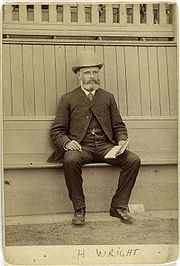 “Tom Wilkes, an art director, photographer and designer whose posters for the Monterey Pop Festival and album covers for the Rolling Stones, Janis Joplin, Joe Cocker, George Harrison and others helped illustrate the age of rock ’n’ roll, died on June 28 in Pioneertown, Calif., in the high desert east of Los Angeles. He was 69. . . .
“Tom Wilkes, an art director, photographer and designer whose posters for the Monterey Pop Festival and album covers for the Rolling Stones, Janis Joplin, Joe Cocker, George Harrison and others helped illustrate the age of rock ’n’ roll, died on June 28 in Pioneertown, Calif., in the high desert east of Los Angeles. He was 69. . . .
“For the Rolling Stones, he created a controversial cover for the album ‘Beggars Banquet,’ using a photograph of a toilet stall with the name of the band prominent on a wall filled with graffiti. The record label initially refused to release the cover, and replaced it with a fake invitation to a dinner. Mr. Wilkes’s version was released later.
“For Dave Mason’s ‘Alone Together,’ Mr. Wilkes photographed Mr. Mason wearing a top hat and a long-tailed coat against a backdrop of canyon rocks. For Joe Cocker’s ‘Mad Dogs & Englishmen,’ he placed a photograph of the long-haired Mr. Cocker flexing his right bicep within an illustration of a mirror frame. For George Harrison’s ‘All Things Must Pass,’ he depicted the former Beatle as if he were a woodsman in a fairy tale, surrounded by reclining trolls.
“Only hours before Janis Joplin’s fatal drug overdose in 1970, Mr. Wilkes photographed her for the album ‘Pearl,’ colorfully dressed and coiffed and looking remarkably relaxed and happy. He photographed Eric Clapton, sitting in a chair in a white suit, for his first solo album, and for Neil Young’s ‘Harvest,’ he created the typescript title over a red sun set against a wheat-colored background.” (more @ NY Times)
Read Full Post »
 “Gordon Waller, who formed half of Peter and Gordon, a successful pop duo that followed the Beatles to America as part of the British Invasion of the 1960s and that scored a No. 1 hit with ‘A World Without Love,’ died on Friday in Norwich, Conn. He was 64 and lived in Ledyard, Conn. . . .
“Gordon Waller, who formed half of Peter and Gordon, a successful pop duo that followed the Beatles to America as part of the British Invasion of the 1960s and that scored a No. 1 hit with ‘A World Without Love,’ died on Friday in Norwich, Conn. He was 64 and lived in Ledyard, Conn. . . .
 “On Bastille Day, as chefs from the Flatiron District were holding a benefit in Madison Square Park inspired by food from around the world, a couple of blocks away Michael Steinberger was sounding the death knell for the most legendary cuisine of all. The occasion was the launch, at
“On Bastille Day, as chefs from the Flatiron District were holding a benefit in Madison Square Park inspired by food from around the world, a couple of blocks away Michael Steinberger was sounding the death knell for the most legendary cuisine of all. The occasion was the launch, at  “
“ “It took more than 30 years for the creators of Pez candy dispensers to give the little plastic figurines feet, and they never did get hands. But now the long arm of the
“It took more than 30 years for the creators of Pez candy dispensers to give the little plastic figurines feet, and they never did get hands. But now the long arm of the  “John Heneghan tugged a large shellac disc from its brown paper sleeve, placed it on a turntable and gently nudged a needle into place. Behind him, in the corner of his East Village apartment, sat 16 wooden crates, each filled with meticulously cataloged 78-r.p.m. records. The coarse, crackling voice of the blues singer Charley Patton, performing ‘High Water Everywhere Part 1,’ his startling account of the 1927 Mississippi River flood, rose from the speakers, raw and unruly. The record is worth about $8,000.
“John Heneghan tugged a large shellac disc from its brown paper sleeve, placed it on a turntable and gently nudged a needle into place. Behind him, in the corner of his East Village apartment, sat 16 wooden crates, each filled with meticulously cataloged 78-r.p.m. records. The coarse, crackling voice of the blues singer Charley Patton, performing ‘High Water Everywhere Part 1,’ his startling account of the 1927 Mississippi River flood, rose from the speakers, raw and unruly. The record is worth about $8,000. “
“